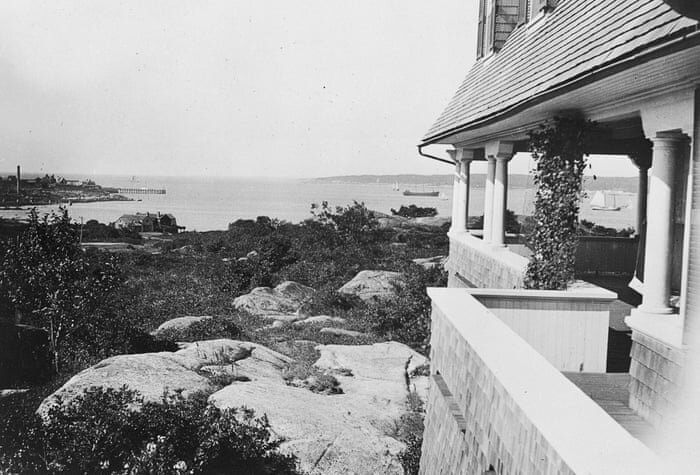The World Class Culture of Greater Cape Ann
Special Edition
The Cape Ann School of Painting
Since the 19th century, artists in search of inspiration have trekked to the Cape Ann peninsula where the changing scenery contains every combination of seasons, tides, sunrises, moonlight, foliage, and countless vessels. Over the decades, Cape Ann grew into one of the world’s most renowned artistic destinations, producing many revered painters. Artists such as Fitz Henry Lane, Winslow Homer, Jane Peterson, and Marsden Hartley translated the scenery into now legendary works of art.
A legion of artists followed these first painters, and eventually became known as the Cape Ann School of Painting, with their collective artwork capturing the region’s evocative beauty. Many artists of the Cape Ann School of Painting have become highly valued by collectors and museums the world over.
Nell Blaine (1922-1996), another legendary artist associated with Gloucester, created vibrant paintings of natural scenery as well as interior compositions reminiscent of Matisse. Heroically, after contracting polio and relearning her trade, Blaine produced much of her most brilliant work; many of her paintings are now in permanent collections of the world’s museums.
Today, the local art community contains new genres, including the Cape Ann Plein Air painters, the Experimental Group of modernists, graphic designers using digital methods, photographers populating Instagram, aspiring amateur painters, and the newly arrived video artists.
The inspiration of Cape Ann never diminishes.
The trek to the peninsula never ceases.
Bing McGilvray, Schooner Days
A Premier Museum Destination
The Janet & William Ellery James Center at the Cape Ann Museum Green. Photo: Steve Rosenthal, July 2020.
The profusion of artistic activity on Cape Ann eventually fostered museums, associations, galleries, and art schools, all central to the region growing into one of the world’s most attractive cultural destinations.
The Cape Ann Museum, founded in 1875, exists to preserve and celebrate the history and culture of the area. The museum includes a dedicated Fitz Henry Lane Gallery at the Pleasant Street location. Fitz Henry Lane (1804-1865) was born in Gloucester and lived on the harbor’s waterfront. In his lifetime he became America’s premier painter of marine subjects, developing a style that combined precise detail with expansive luminescent skies.
The Cape Ann Museum will significantly expand in 2021 with the opening of Cape Ann Museum Green, a nearly four-acre campus including a contemporary gallery, historic buildings and an expansive green lawn destined for development into a sculpture park.
Rockport Art Association & Museum, Main Street, Rockport.
Founded in 1921, The Rockport Art Association & Museum (RAA&M) now serves as the chief steward of the Cape Ann School of Painting. Located in the thick of Rockport’s commercial area, RAA&M is comprised of several galleries continuously offering exhibitions. The annual RAA&M auction of heritage artwork attracts global collectors for the works of Jane Peterson, Emile Gruppe, Aldro Hibbard, Charles Movalli, and the many other now legendary painters of Cape Ann.
The Peabody Essex Museum (PEM) was founded in 1799 by Salem sea captains as a repository for their collectibles acquired during those first maritime voyages to the world’s distant ports. PEM, now the “nation’s oldest continuously operating museum”, has evolved into the North Shore’s portal to world class American and international art.
In addition to the museums, two local arts associations are highly valued in the current cultural life of Cape Ann. The North Shore Arts Association was founded in 1922, with spacious harborside galleries that serve many exhibitions. The Rocky Neck Art Colony has been part of the working art colony for more than 150 years, when many painters had homes and studios in the Rocky Neck district of Gloucester. Today the organization serves members and non-members with exhibitions, galleries, and classes.
A Unique Gallery Destination
(left) Christine Whalen-Waller, Gallery Walk. (right) Opening Reception for Antony Ohman. Jane Deering Gallery.
Many independent art galleries are now scattered across Cape Ann. Jane Deering, who once ran Art Remarks (1999-2003), an art discovery program based in London, opened the Jane Deering Gallery in 2002 with a second gallery in Santa Barbara, California in 2011. The Gloucester gallery represents emerging and established artists from the US and abroad, and has a strong interest in artists living and working on Cape Ann.
Next door to the Jane Deering Gallery is the Beth Williams Studio, with contemporary handmade art-glass beads and jewelry. Around the corner on Main Street, gallery explorers will find Charles Fine Arts and Matthew Swift Gallery. Art patrons in Rockport have many galleries to enjoy, including the Tom Nicholas Gallery, Ken Knowles Fine Art, I Art Colony, Scott Tubby Fine Art, Canterbury Hill Studio and Gallery, and the Art of David Arsenault.
Rockport Music-Shalin Liu Performance Center. “New England’s most magical spot for chamber music.” —The Boston Globe
Natural Venues for Music, Theater, Dance
Once Cape Ann became known as an artistic outpost, next followed the musicians, actors, playwrights, and dancers, with their own needs for theaters, concert halls and performance stages.
Another exceptional Cape Ann cultural destination is Rockport Music -Shalin Liu Performance Center, with its concert hall built on an intimate scale, including a stage that overlooks Rockport’s Sandy Bay. During their fully booked seasons the musical offerings are the best of the classical, jazz, and folk genres. The organization also features HD broadcasts from the Metropolitan Opera and the National Theatre.
In addition, the musical abundance on Cape Ann includes regional symphonies and choral groups of the highest quality of musicianship, among them Cape Ann Symphony, Symphony by the Sea, and Chorus North Shore.
Dancers perform on the outdoor stage at Windhover Performing Arts Center.
In 1967, Herbert and Ina Hahn, a former professional dancer in New York, moved to Rockport where they converted a farm into a summer youth camp for the performing arts. Today, the enclave has evolved into a complex known as Windhover Performing Arts Center, with an outdoor performance pavilion nestled into the natural land formation.
For the live theater patrons, Gloucester Stage, is another local treasure. Every year they stage a seasonal schedule of innovative productions casting professional actors performing in their intimate and near circular theater. The remaining calendar is booked with original creations, often derived from local authors and actors.
Another cherished community theatre group is Annisquam Village Players, operating since 1917, and known for their irreverent annual summer production.
The Stewards of Literature and History
T. S. Eliot House, Gloucester. Photograph copyright Estate of T. S. Eliot
Nobel Prize winning poet T.S. Eliot spent his youth at the family summer home in East Gloucester. His imprinted memories of Cape Ann became stanzas in his opus, The Four Quartets. In 2015, the T. S. Eliot Foundation purchased the Eliot family’s spacious summer home, which is now the T.S. Eliot House, refurbished to serve as a writer’s retreat, open to poets, playwrights, essayists, and editors.
The river is within us, the sea is all about us;
The sea is the land’s edge, also the granite
Into which it reaches, the beaches where it tosses
Its hints of earlier and other creation:
The starfish, the horseshoe crab, the whale’s backbone
T. S. Eliot, passage from “The Dry Salvages,” The Four Quartets
The wonderful Historical Societies of Cape Ann are to be taken seriously. With lectures by dedicated scholars, they keep the memories of Cape Ann’s ancestors alive. Local history destinations include the Manchester Historical Museum, the Ipswich Historical Society, Historic Beverly, and the Wenham Museum.
Two organizations nurture the literary life of Cape Ann. Gloucester Writers Center (GWC) and Literary Cape Ann both offer scholarly events as well as practical workshops on the craft of writing and publishing. The Rockport Poetry Festival celebrates the spoken and written word.
Literary mavens will find many books to covet at Cape Ann’s charming independent bookstores, including Dogtown Books in Gloucester, Manchester by the Book in Manchester-by-the-Sea, and Art Longwood Books in Rockport, for the bibliophile in search of rare publications on the visual arts.
Ipswich Historical Society
(left) Beauport Sleeper-McCann House. Photo credit: Gloucester Daily Times. (right) Hammond Castle Museum.
The Crown Jewels of Cape Ann
Central to the rich cultural venues of Cape Ann are several particularly magnificent destinations. Each combines a unique historical genesis with irreplaceable period architecture – and elegant links to a once formal era of society on Cape Ann.
The Beauport Sleeper-McCann House, constructed 1907-1934 and perched on a rocky ledge overlooking Gloucester Harbor, was built by Henry Davis Sleeper, one of the first successful interior decorators. The house grew to 56 rooms, becoming his design laboratory and a popular feature in design magazines. Today, the Beauport Sleeper-McCann house is open for tours and remains largely intact as a living showcase for Sleeper’s interior design concepts.
Another magnificent Gloucester destination is the former home of inventor and music lover John Hayes Hammond, Jr. The Hammond Castle, completed, in 1929, represented his dream house with Medieval elements and a large pipe organ in the Great Hall. The Hammond Castle Museum is now an integral part of Cape Ann culture, utilized for concerts, lectures, picnics on the grounds and general tours.
The Cabot Performing Art Center, refurbished and ready to reopen.
In Ipswich, The Crane Estate, established in 1910 and situated on the ocean, includes The Great House, designed by world-renowned architect David Adler as a 59-room Stuart-style mansion. Today it is a grand destination for a range of cultural events open to the public and is also available for private events.
In downtown Beverly, The Cabot Performing Art Center celebrated its centennial anniversary in 2020. The theater, with 800 seats, was once the local movie house for Hollywood’s new releases. Fortunately, a group of investors rescued the historic theater from destruction, with the interior architecture now undergoing full restoration. The Cabot is back on track to become one of the region’s most elegant entertainment venues.
The Manship Artists Residency + Studios is another historic site restored from a bygone era. The original owner was sculptor Paul Manship, creator of the Prometheus Fountain at Rockefeller Center, New York City, and he once used the site as his summer home and studio. The property is now dedicated to providing an international, interdisciplinary artists' residency, intended to benefit the community and visitors to Cape Ann.
Manship Artists Residency + Studios.
Gloucester’s Growing Science Hub
With Gloucester’s centuries of fishing the oceans, the need for improved management of marine resources has stimulated scientific research. A burgeoning science community now includes several world-class research institutions.
Founded in 1971 by cetologist Roger Payne and operating out of the old Paint Factory building at the head of the Gloucester harbor, Ocean Alliance conducts whale conservation research on projects the world over. Gloucester Marine Genomics Institute, founded in 2013, is the world’s first dedicated marine genomics research institute, now operating from a state-of-the-art research facility on Gloucester’s inner harbor.
Maritime Gloucester, situated on the waterfront in downtown Gloucester, is a mixed-usage complex including a museum, aquarium, youth programs, with a new educational science center planned for 2021. Gloucester Marine Station, part of University of Massachusetts, is an educational and research site founded to study sustainable fisheries and to pursue “blue economy” opportunities.
Jon Corbino, (1905-1964), Opening Night.
Plans Rebound for 2021 Major Cultural Events

















